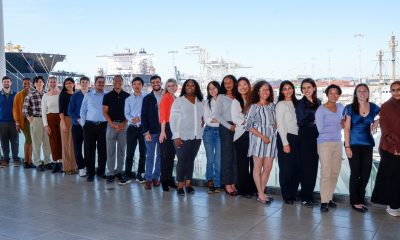Activism
Port Workers and West Oakland Residents Oppose A’s New Ballpark

Over 100 community members attended a discussion held by leaders of the International Longshore and Warehouse Union (ILWU) Local 10 on Sept. 21, to oppose the Oakland Athletics’ plans to build a new ballpark at Howard Terminal.
“This is not about baseball, this is about gobbling up land, this is a real estate investment,” said event organizer and former ILWU Local 10 Secretary-Treasurer Derrick Muhammad as he addressed the crowd gathered at the West Oakland Senior Center.
The A’s proposal to build a stadium at Howard Terminal on the Port of Oakland includes the construction of 3,000 condominiums, a 400 room hotel, and a multi-million dollar gondola to transport fans to and from the park.
ILWU leaders and West Oakland community members expressed concerns about the implications of a ballpark on the city’s industrial waterfront.
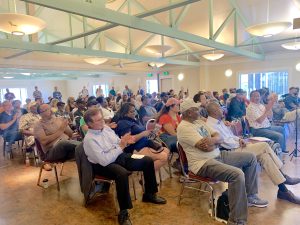
Over 100 community members and port workers gathered at the West Oakland Senior Center to oppose the A’s plans for a new ballpark at Howard Terminal.
“We believe that once you start placing houses adjacent to industry, you subject that industry to complaints of the neighbors,” said Muhammad, who fears that in the long run Oakland could suffer the same fate as Detroit, which some have called a “ghost town” in reference to large swaths of the city that were abandoned after the decline of the automotive industry between 2008 and 2010.
The A’s plan to flank their new ballpark with 3,000 apartments, in the middle of Oakland’s industrial hub where air pollution is some of the highest in the Bay Area. A few hundred yards adjacent to Howard Terminal, recycling plant Schnitzer Steel grinds up and recycles on average over 500,000 metric tons of cars, household appliances and scrap metals per year, according to their 2017-2018 Sustainability Report. While the company has significantly reduced emissions in recent years, during the day acrid smells waft from the plant on to the Howard Terminal lot.
Meanwhile, the A’s are promoting their project as an environmental solution. A Feb. 15 report by the San Francisco Chronicle found that decades of industrial activity had contaminated the soil and groundwater at Howard Terminal with “hazardous” and “cancer-causing chemicals,” that would require removal prior to construction.
On their website, the A’s pledge to “fully remediate these environmental issues at no cost to taxpayers,” along with the rest of the project that they promise will be “100 percent privately financed by the Oakland A’s.”
This statement comes in contrast to a California bill in the works, SB 293, which would potentially allocate millions in public tax money to cover costs for anything from transportation and waste management, to the “remediation of hazardous materials,” on the Howard Terminal property.
If signed by Gov. Newsom, SB 293 will fund the infrastructure needed for the ballpark by creating a new Oakland tax district and will cover any costs related to making the Howard Terminal site buildable and accessible. Major challenges facing the project include sea level mitigation, removal of toxic waste, and transportation infrastructure.
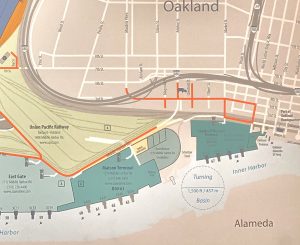
A map depicting the current access points for the Port of Oakland and Howard Terminal.
Aaron Wright, ILWU Local 10 business agent, called the stadium nothing short of a “billionaire’s dream,” and said that the A’s have not taken into account the implications of building on such a challenging site. At the event, he urged community members to “say hell no” to allowing their tax money to subsidize a “billionaire’s condo paradise.”
Howard Terminal is a 50-acre site with a single access point via Market Street. It’s one-third of the size of the Coliseum, which spans 150 acres, and is nearly one mile from the nearest BART station.
Wright also takes issue with Howard Terminal being touted as an “unused” site by project supporters. According to him, the lot serves as an important hub for the hundreds of truckers entering and exiting the port each day, who would otherwise be parking on Oakland streets, clogging the freeways, and increasing pollution in residential West Oakland.
“Howard Terminal actually took that traffic off the streets and gave them a place to stage their loads…it really is a mechanism to keep trucks off the road, to keep trucks out of West Oakland streets,” said Wright.
Due to the spatial restrictions of the lot, the A’s plan to build a substantially smaller parking lot for the stadium, and want to encourage sports fans to leave their cars behind by building a $123 million gondola that would transport up to 6,000 fans per hour per direction from West Oakland BART station to Jack London Square.
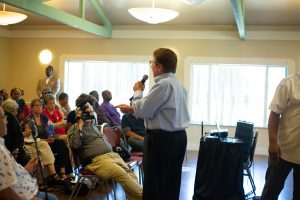
Andrew Garcia, president, and director of marine transportation company GoodBulk Ltd addresses Oaklander at the community meeting on Sept. 21. Photo by Saskia Hatvany.
“The west Oakland community — if that stadium is built — will become the parking lot of the Oakland A’s. There is no way that you will be able to control 20 or 30,000 sports fans coming to a stadium on the waterfront,” said Andrew Garcia, president, and director of marine transportation company GoodBulk Ltd., who also spoke at the event.
Another concern for the ILWU is the “turning circle,” a widened part of the estuary where large cargo ships turn around between loading and unloading. The largest ships can barely turn in the existing space and require careful maneuvering from the bar pilots, who have also opposed the stadium over concerns that lights from the new stadium will blind them. As ships get bigger, the Port will no longer be able to accommodate them unless the estuary is adapted, Wright said.
In response to the concerns, the Port of Oakland has laid down its conditions in a project overview and reserved the right to expand the turning basin up to 10 acres of Howard Terminal. The residential development would only be permitted on the side further away from the industrial operations and would have to include a “comprehensive transportation and circulation plan” to ensure that Port operations remain unaffected.
Still, Muhammad suspects that if the project moves forward, there will be larger socio-economic implications.
“This project would be the last few nails in that coffin of gentrification that west Oakland currently finds itself in,” said Muhammad, who expressed skepticism at the 5,000 jobs that the A’s promised to generate with the new ballpark. He and other industry workers are concerned that the new employment opportunities will consist of low-paying, part-time service jobs — aside from the promised 2,000 construction jobs, which Muhammad argues are temporary.
In addition to the stadium at Howard Terminal, the A’s wish to purchase the Coliseum land from the City of Oakland. Preliminary digital renderings show the 150-acre lot transformed into a large green space surrounding an open-air baseball diamond, flanked by shopping centers, a university campus, and residential areas — including affordable housing.
“Howard Terminal is a 50-acre site…that needs a huge amount of funds to make it buildable. And you could go over to the Coliseum — three times as large, 150 acres — and build three times the stadium and hotel and houses over there, tomorrow,” said Wright.
“It just seems like they’re trying to double dip…and it seems like they’re more interested in developing real estate than just getting a place to play ball,” said Muhammad.
The ILWU is confident that their movement will grow as stadium plans move forward. They are currently working on building alliances with other local industries and non-profits in the area, as well as residents of East Oakland and West Oakland, and urge those who oppose the project to attend future meetings.
The Oakland Post has reached out the the A’s, and welcomes their response to the concerns covered in this article.
For more information about the movement against the Howard Terminal Ballpark, contact Derrick Muhammad at dmuhammad@gmail.com, (510) 435 2713.
Activism
Big God Ministry Gives Away Toys in Marin City
Pastor Hall also gave a message of encouragement to the crowd, thanking Jesus for the “best year of their lives.” He asked each of the children what they wanted to be when they grow up.

By Godfrey Lee
Big God Ministries, pastored by David Hall, gave toys to the children in Marin City on Monday, Dec. 15, on the lawn near the corner of Drake Avenue and Donahue Street.
Pastor Hall also gave a message of encouragement to the crowd, thanking Jesus for the “best year of their lives.” He asked each of the children what they wanted to be when they grew up.
Around 75 parents and children were there to receive the presents, which consisted mainly of Gideon Bibles, Cat in the Hat pillows, Barbie dolls, Tonka trucks, and Lego building sets.
A half dozen volunteers from the Big God Ministry, including Donnie Roary, helped to set up the tables for the toy giveaway. The worship music was sung by Ruby Friedman, Keri Carpenter, and Jake Monaghan, who also played the accordion.
Big God Ministries meets on Sundays at 10 a.m. at the Mill Valley Community Center, 180 Camino Alto, Mill Valley, CA Their phone number is (415) 797-2567.
Activism
First 5 Alameda County Distributes Over $8 Million in First Wave of Critical Relief Funds for Historically Underpaid Caregivers
“Family, Friend, and Neighbor caregivers are lifelines for so many children and families in Alameda County,” said Kristin Spanos, CEO, First 5 Alameda County. “Yet, they often go unrecognized and undercompensated for their labor and ability to give individualized, culturally connected care. At First 5, we support the conditions that allow families to thrive, and getting this money into the hands of these caregivers and families at a time of heightened financial stress for parents is part of that commitment.”

Family, Friend, and Neighbor Caregivers Can Now Opt Into $4,000 Grants to Help Bolster Economic Stability and Strengthen Early Learning Experiences
By Post Staff
Today, First 5 Alameda County announced the distribution of $4,000 relief grants to more than 2,000 Family, Friend, and Neighbor (FFN) caregivers, totaling over $8 million in the first round of funding. Over the full course of the funding initiative, First 5 Alameda County anticipates supporting over 3,000 FFN caregivers, who collectively care for an estimated 5,200 children across Alameda County. These grants are only a portion of the estimated $190 million being invested into expanding our early childcare system through direct caregiver relief to upcoming facilities, shelter, and long-term sustainability investments for providers fromMeasure C in its first year. This investment builds on the early rollout of Measure C and reflects a comprehensive, system-wide strategy to strengthen Alameda County’s early childhood ecosystem so families can rely on sustainable, accessible care,
These important caregivers provide child care in Alameda County to their relatives, friends, and neighbors. While public benefits continue to decrease for families, and inflation and the cost of living continue to rise, these grants provide direct economic support for FFN caregivers, whose wages have historically been very low or nonexistent, and very few of whom receive benefits. As families continue to face growing financial pressures, especially during the winter and holiday season, these grants will help these caregivers with living expenses such as rent, utilities, supplies, and food.
“Family, Friend, and Neighbor caregivers are lifelines for so many children and families in Alameda County,” said Kristin Spanos, CEO, First 5 Alameda County. “Yet, they often go unrecognized and undercompensated for their labor and ability to give individualized, culturally connected care. At First 5, we support the conditions that allow families to thrive, and getting this money into the hands of these caregivers and families at a time of heightened financial stress for parents is part of that commitment.”
The funding for these relief grants comes from Measure C, a local voter-approved sales tax in Alameda County that invests in young children, their families, communities, providers, and caregivers. Within the first year of First 5’s 5-Year Plan for Measure C, in addition to the relief grants to informal FFN caregivers, other significant investments will benefit licensed child care providers. These investments include over $40 million in Early Care and Education (ECE) Emergency Grants, which have already flowed to nearly 800 center-based and family child care providers. As part of First 5’s 5-Year Plan, preparations are also underway to distribute facilities grants early next year for child care providers who need to make urgent repairs or improvements, and to launch the Emergency Revolving Fund in Spring 2026 to support licensed child care providers in Alameda County who are at risk of closure.
The FFN Relief Grants recognize and support the essential work that an estimated 3,000 FFN caregivers provide to 5,200 children in Alameda County. There is still an opportunity to receive funds for FFN caregivers who have not yet received them.
In partnership with First 5 Alameda County, Child Care Payment Agencies play a critical role in identifying eligible caregivers and leading coordinated outreach efforts to ensure FFN caregivers are informed of and able to access these relief funds.FFN caregivers are eligible for the grant if they receive a child care payment from an Alameda County Child Care Payment Agency, 4Cs of Alameda County, BANANAS, Hively, and Davis Street, and are currently caring for a child 12 years old or younger in Alameda County. Additionally, FFN caregivers who provided care for a child 12 years or younger at any time since April 1, 2025, but are no longer doing so, are also eligible for the funds. Eligible caregivers are being contacted by their Child Care Payment Agency on a rolling basis, beginning with those who provided care between April and July 2025.
“This money is coming to me at a critical time of heightened economic strain,” said Jill Morton, a caregiver in Oakland, California. “Since I am a non-licensed childcare provider, I didn’t think I was eligible for this financial support. I was relieved that this money can help pay my rent, purchase learning materials for the children as well as enhance childcare, buy groceries and take care of grandchildren.”
Eligible FFN caregivers who provided care at any time between April 1, 2025 and July 31, 2025, who haven’t yet opted into the process, are encouraged to check their mail and email for an eligibility letter. Those who have cared for a child after this period should expect to receive communications from their child care payment agency in the coming months. FFN caregivers with questions may also contact the agency they work with to receive child care payments, or the First 5 Alameda help desk, Monday through Friday, from 9 a.m. to 5:00 p.m. PST, at 510-227-6964. The help desk will be closed 12/25/25 – 1/1/26. Additional grant payments will be made on a rolling basis as opt-ins are received by the four child care payment agencies in Alameda County.
Beginning in the second year of Measure C implementation, FFN caregivers who care for a child from birth to age five and receive an Alameda County subsidized voucher will get an additional $500 per month. This amounts to an annual increase of about $6,000 per child receiving a subsidy. Together with more Measure C funding expected to flow back into the community as part of First 5’s 5-Year Plan, investments will continue to become available in the coming year for addressing the needs of childcare providers in Alameda County.
About First 5 Alameda County
First 5 Alameda County builds the local childhood systems and supports needed to ensure our county’s youngest children are safe, healthy, and ready to succeed in school and life.
Our Mission
In partnership with the community, we support a county-wide continuous prevention and early intervention system that promotes optimal health and development, narrows disparities, and improves the lives of children from birth to age five and their families.
Our Vision
Every child in Alameda County will have optimal health, development, and well-being to reach their greatest potential.
Learn more at www.first5alameda.org.
Activism
2025 in Review: Seven Questions for Assemblymember Lori Wilson — Advocate for Equity, the Environment, and More
Her rise has also included several historic firsts: she is the only Black woman ever appointed to lead the influential Assembly Transportation Committee, and the first freshman legislator elected Chair of the California Legislative Black Caucus. She has also been a vocal advocate for vulnerable communities, becoming the first California legislator to publicly discuss being the parent of a transgender child — an act of visibility that has helped advanced representation at a time when political tensions related to social issues and culture have intensified.
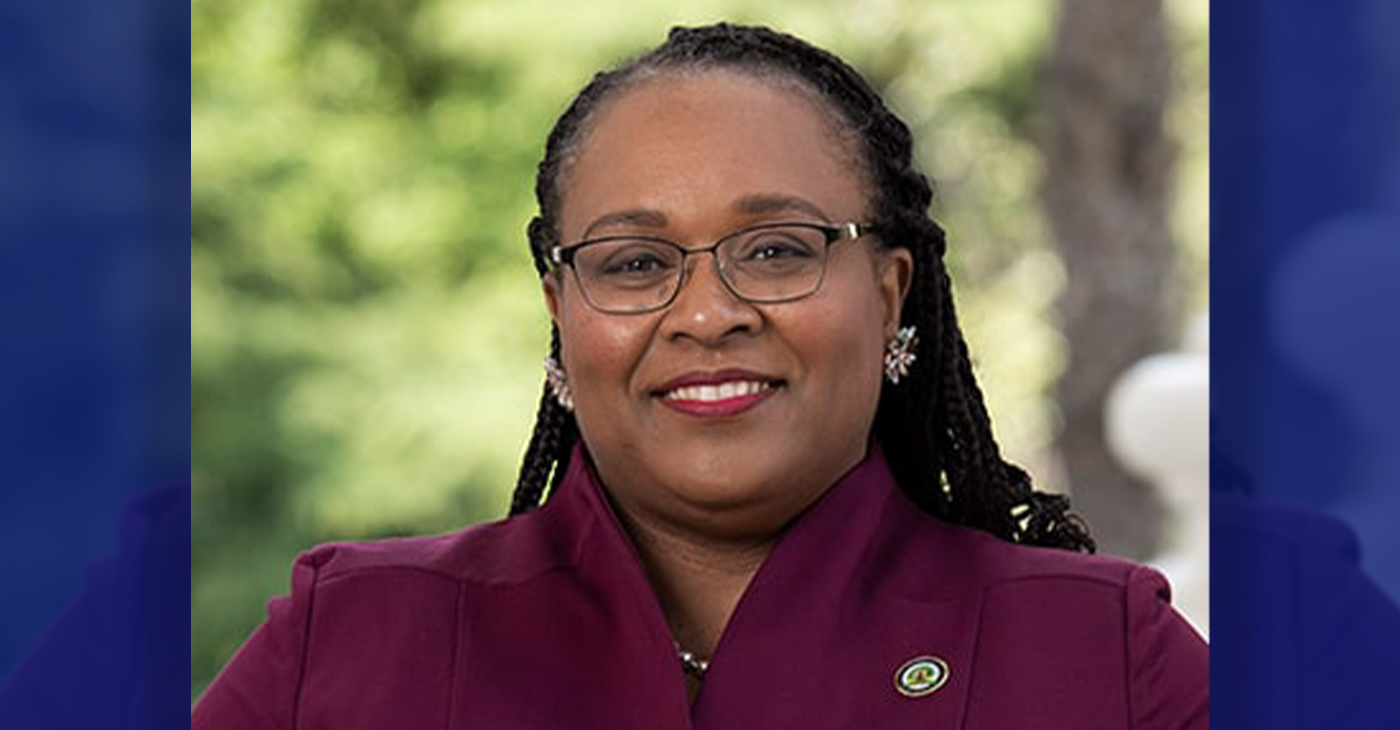
By Edward Henderson, California Black Media
Assemblymember Lori D. Wilson (D-Suisun City) joined the California Legislature in 2022 after making history as Solano County’s first Black female mayor, bringing with her a track record of fiscal discipline, community investment, and inclusive leadership.
She represents the state’s 11th Assembly District, which spans Solano County and portions of Contra Costa and Sacramento Counties.
Her rise has also included several historic firsts: she is the only Black woman ever appointed to lead the influential Assembly Transportation Committee, and the first freshman legislator elected Chair of the California Legislative Black Caucus. She has also been a vocal advocate for vulnerable communities, becoming the first California legislator to publicly discuss being the parent of a transgender child — an act of visibility that has helped advanced representation at a time when political tensions related to social issues and culture have intensified.
California Black Media spoke with Wilson about her successes and disappointments this year and her outlook for 2026.
What stands out as your most important achievement this year?
Getting SB 237 passed in the Assembly. I had the opportunity to co-lead a diverse workgroup of colleagues, spanning a wide range of ideological perspectives on environmental issues.
How did your leadership contribute to improving the lives of Black Californians this year?
The Black Caucus concentrated on the Road to Repair package and prioritized passing a crucial bill that remained incomplete during my time as chair, which establishes a process for identifying descendants of enslaved people for benefit eligibility.
What frustrated you the most this year?
The lack of progress made on getting Prop 4 funds allocated to socially disadvantaged farmers. This delay has real consequences. These farmers have been waiting for essential support that was promised. Watching the process stall, despite the clear need and clear intent of the voters, has been deeply frustrating and reinforces how much work remains to make our systems more responsive and equitable.
What inspired you the most this year?
The resilience of Californians persists despite the unprecedented attacks from the federal government. Watching people stay engaged, hopeful, and determined reminded me why this work matters and why we must continue to protect the rights of every community in our state.
What is one lesson you learned this year that will inform your decision-making next year?
As a legislator, I have the authority to demand answers to my questions — and accept nothing less. That clarity has strengthened my approach to oversight and accountability.
In one word, what is the biggest challenge Black Californians are facing currently?
Affordability and access to quality educational opportunities.
What is the goal you want to achieve most in 2026?
Advance my legislative agenda despite a complex budget environment. The needs across our communities are real, and even in a tight fiscal year, I’m committed to moving forward policies that strengthen safety, expand opportunity, and improve quality of life for the people I represent.
-

 Alameda County4 weeks ago
Alameda County4 weeks agoSeth Curry Makes Impressive Debut with the Golden State Warriors
-
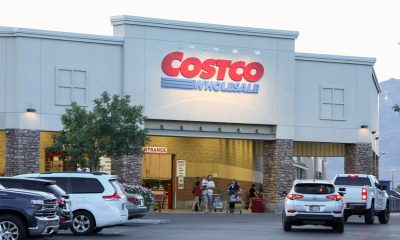
 Bay Area3 weeks ago
Bay Area3 weeks agoPost Salon to Discuss Proposal to Bring Costco to Oakland Community meeting to be held at City Hall, Thursday, Dec. 18
-

 #NNPA BlackPress4 weeks ago
#NNPA BlackPress4 weeks agoFBI Report Warns of Fear, Paralysis, And Political Turmoil Under Director Kash Patel
-

 Activism3 weeks ago
Activism3 weeks agoMayor Lee, City Leaders Announce $334 Million Bond Sale for Affordable Housing, Roads, Park Renovations, Libraries and Senior Centers
-

 Activism3 weeks ago
Activism3 weeks agoOakland Post: Week of December 10 – 16, 2025
-
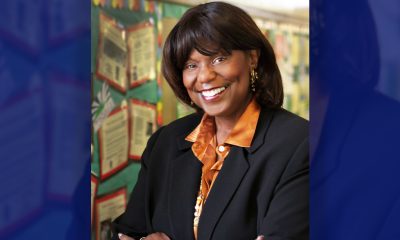
 Activism3 weeks ago
Activism3 weeks agoOakland School Board Grapples with Potential $100 Million Shortfall Next Year
-

 Arts and Culture3 weeks ago
Arts and Culture3 weeks agoFayeth Gardens Holds 3rd Annual Kwanzaa Celebration at Hayward City Hall on Dec. 28
-

 Activism3 weeks ago
Activism3 weeks ago2025 in Review: Seven Questions for Black Women’s Think Tank Founder Kellie Todd Griffin







